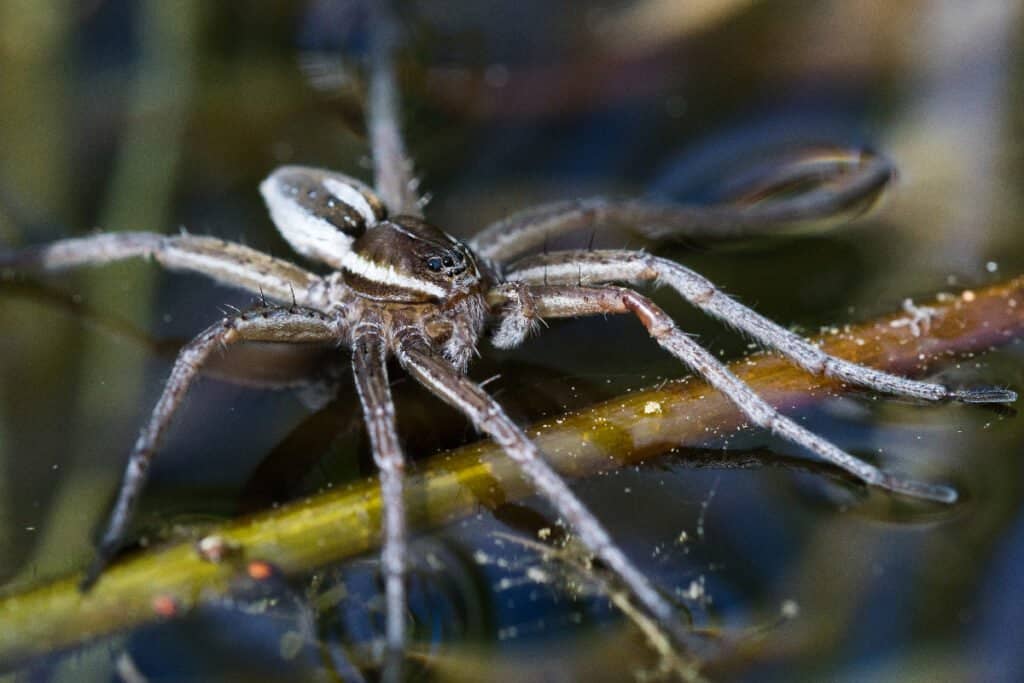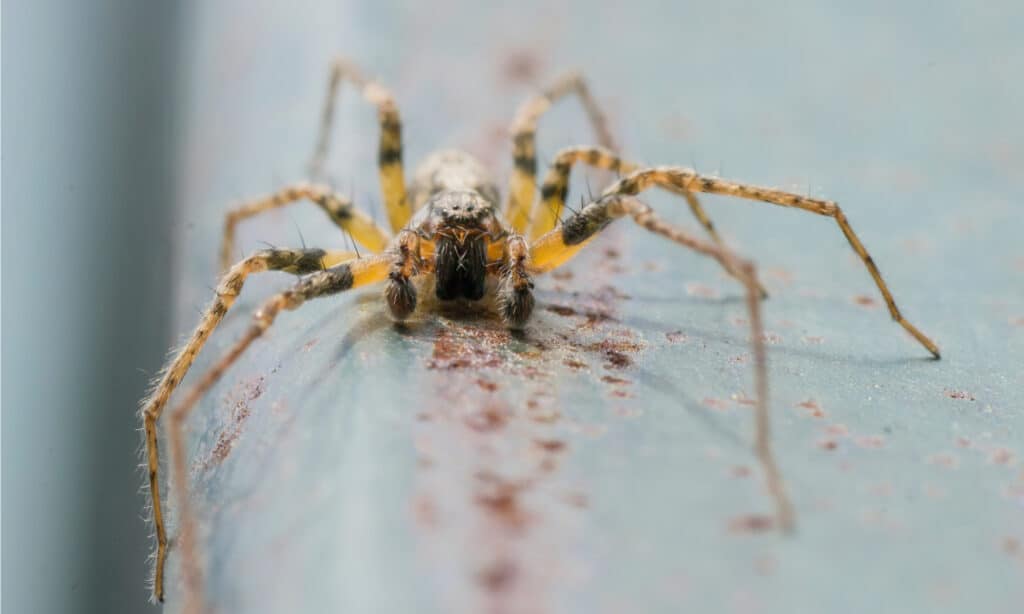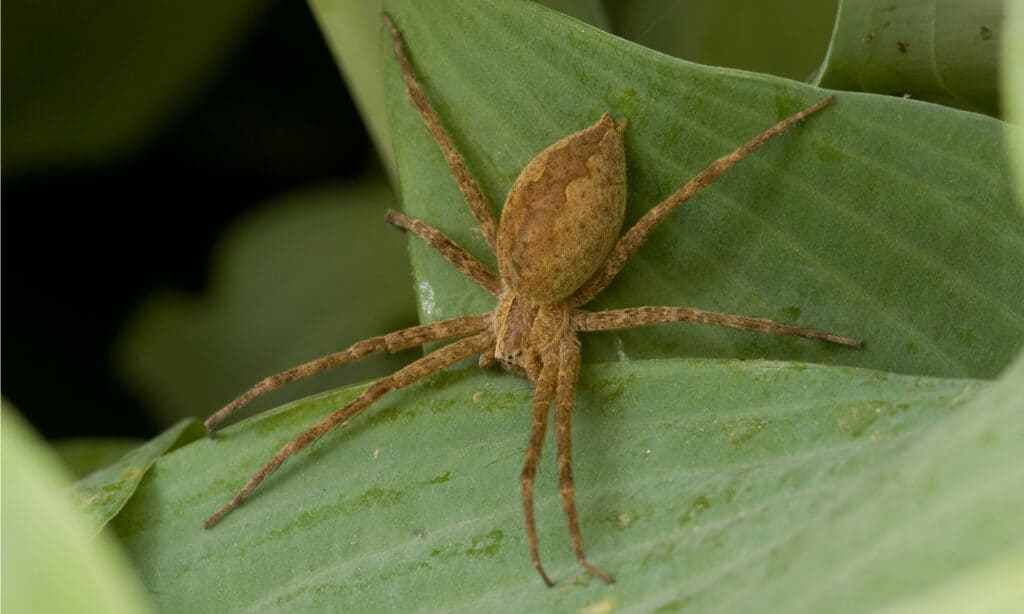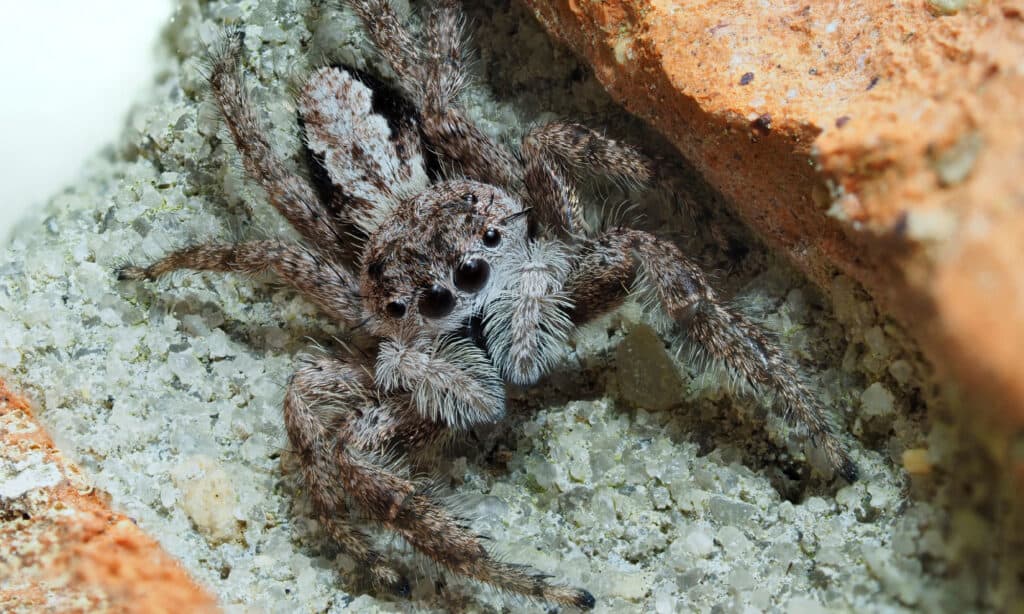
Spiders are divisive creatures that frighten some and fascinate others. Yet, despite how these creepy crawlies make you feel, they are everywhere, and no one can argue with that. In Pennsylvania, 45 spider species populate fields, wetlands, forests, and even homes. Although many of these spiders are harmless, a few species of brown spiders in Pennsylvania can be potentially dangerous to humans. Whether you love or loathe them, spiders are integral to Pennsylvania’s wildlife. By learning more about these fascinating creatures, we can better appreciate their unique characteristics and important role in our environment. Let’s discover more about seven brown spiders in Pennsylvania!
1. Six-Spotted Fishing Spider (Dolomedes triton)
The six-spotted fishing spider is one of the largest brown spiders in Pennsylvania.
A distinct feature of the six-spotted fishing spider is its brown to brownish-gray body, with a white to pale cream stripe on both sides of the cephalothorax. This spider’s abdomen is also marked with several light-colored spots and dull white lines running along its sides.
As is common for many spider species, when it comes to size, the female Six-spotted fishing spider is larger than the male. The female’s length, including the legs, can reach up to 2.4 inches, with a body length ranging from 0.59 to 0.79 inches. Meanwhile, the male’s body is only 0.35 to 0.51 inches long.
When hunting, the spider perches itself on floating vegetation, using three of its front legs to detect ripples and vibrations in the water. It can even dive up to seven inches underwater to catch prey or evade predators. Interestingly, the spider can create a bubble of air that enables it to stay submerged for up to thirty minutes.
The semi-aquatic six-spotted fishing spider thrives in wetland areas such as the edges of ponds and lakes and slow-moving streams.
These spiders have a diverse diet that includes aquatic insects, neuston organisms, and terrestrial insects that accidentally fall into the water. In addition, they also feed on tadpoles, frogs, and even small fish, making them one of the few spider species capable of preying on vertebrates.
In the event of a bite, the pain is comparable to that of a bee or wasp sting and not more severe.
Fun Facts
- Female cannibalism may lead to mating being the male’s final act.
- Immature adults hibernate in different locations near water, such as under loose bark, other debris, or under stones.
- It can float on water and even run across the water’s surface, much like a water strider.

The six-spotted fishing spider can catch fish more than five times its own size!
©Jukka Jantunen/Shutterstock.com
2. Barn Funnel Weaver (Tegenaria domestica)
The barn funnel weaver is a rare brown spider in Pennsylvania.
The barn funnel weaver displays hues of dark brown, reddish-brown, and even pale yellow. Chevrons pattern the abdomen, and the cephalothorax has two dark lines on both sides of its center. This spider species can easily be identified by its long legs, which have black-brown banding.
Upon reaching maturity, the spider typically attains a body length (not including its legs) between 1/3 to 2/3 inches.
Similar to its fellow funnel weaver spiders, the barn funnel weaver captures prey with its horizontal sheet web that has vertical strands strategically placed to trap passing insects. The web has a narrow funnel “retreat” located in one corner, typically concealed within a recessed area for added protection. These spiders tend to stay near the entrance of their retreat, waiting for an opportune moment to dash out and capture suitable prey that crosses their web.
The barn funnel weaver lives in various habitats, including sheds and barns on the ground within garden beds and log piles. Additionally, these spiders seek shelter inside buildings.
As predators, these spiders play a crucial role in controlling the population of unwanted insects. Therefore, they are highly beneficial to the ecosystem.
These spiders are non-venomous to humans and bite rarely. As a matter of fact, there have been no recorded instances of Barn Funnel Weaver bites.
Fun Facts
- Tegenaria domestica is a non-native species in Pennsylvania.
- Peak numbers of adult male barn funnel weavers are typically observed in June and July, indicating that this is the mating season.
- Its common name in Europe is “house spider.”

The barn funnel weaver is a rare brown spider in Pennsylvania. It is non-venomous to humans and bites rarely.
©Korovko Gleb/Shutterstock.com
3. Wetland Giant Wolf Spider (Tigrosa helluo)
Wolf spiders are a common sight in Pennsylvania, including the wetland giant wolf spider that belongs to the Lycosidae family.
The wetland giant wolf spider is easily recognizable by its brown carapace and unique yellow stripe that starts from its anterior eyes and extends down the cephalothorax. The spider’s black-spotted underside is another distinguishing feature that sets it apart from other wolf spider species.
In terms of size, adult spiders measure up to 0.66 inches, while the males are comparatively smaller than the females.
Rather than relying on webs to catch prey, the wetland giant wolf spider is an active hunter. These spiders typically live in solitude, depending on their sharp vision and quick reflexes to survive.
They are versatile creatures that thrive in a variety of habitats, including woods, marshes, fields, and riparian areas. However, these spiders tend to gravitate towards wetter environments over drier ones.
Wetland giant wolf spiders typically feed on insects such as fly grubs, crickets, mealworms, beetles, and cockroaches.
Although some individuals may be allergic to the venom of a wolf spider, it is important to note that these spiders are not poisonous, and their bite is not harmful to humans.
Fun Facts
- The wetland giant wolf spider prefers to roam on the ground.
- They are excellent predators.
- These spiders hunt their prey in a wolf-like stalking style.

You can often find wetland giant wolf spiders in marshes or fields close to water.
©Judy Gallagher / Creative Commons – License
4. American Nursery Web Spider (Pisaurina mira)
The American nursery web spider, which is often confused with wolf spiders, is a common brown spider in Pennsylvania.
The American nursery web spider has a distinct appearance, with males and females sporting a yellowish-brown hue. Additionally, some individuals may display a light to dark brown stripe running along their back. Notably, a slender white margin can be observed encircling the abdomen. This spider typically measures around 0.74 inches in size when fully grown.
The sexually cannibalistic behavior and intricate use of silk web during mating are some of the most notable characteristics of this spider. In preparation for copulation, the male strategically employs silk to bind the female’s legs, thereby reducing the risk of being consumed by the female.
Wandering hunters by nature, nursery web spiders can be typically spotted on vegetation or near water margins across Pennsylvania. Their diet primarily consists of insects, including but not limited to gnats and mosquitoes.
The American nursery web spider’s venom is highly effective in incapacitating its prey. However, it is not potent enough to pose a threat to humans or larger animals.
Fun Facts
- American nursery web spiders are common in the eastern United States.
- They are also known as wandering hunters due to their hunting behavior.
- These spiders derive their name from the silk webs they use to hold their eggs.

Male American nursery web spiders will tie females’ legs during mating to avoid being eaten afterward.
©SDeming/Shutterstock.com
5. Common House Spider (Parasteatoda tepidariorum)
Common house spiders are very common brown spiders in Pennsylvania. As the name suggests, these spiders tend to live near human populations in homes, sheds, or barns.
Common house spiders come in a range of colors, typically ranging from gray-brown to dark brown, and feature distinctive banded legs. The spiders’ abdomens are spherical in shape and adorned with a mixture of brown and light-beige markings, while two dark stripes mark their heads and thoraxes.
Measuring less than a quarter of an inch, the common house spider is relatively small in size, with females being slightly larger than males.
If the webs constructed by common house spiders do not ensnare any prey, they will eventually vacate the area and find a new location to build their webs.
Despite being a common sight in many households, these spiders should not be despised. On the contrary, they are actually quite helpful in controlling populations of small insects and pests, such as flies, ants, and mosquitos.
Common house spiders pose no threat to humans, as they are completely harmless.
Fun Facts
- Common house spiders often construct their webs in room corners.
- These spiders may occasionally build their webs in close proximity to one another.
- Some common house spiders feed up to four times per day.

As the name suggests, common house spiders tend to live near human populations in homes, sheds, or barns.
©Sample Stars/Shutterstock.com
6. Bowl And Doily Spider (Frontinella communis)
Bowl and doily spiders are characterized by their shiny, round abdomen, which is relatively large compared to their small body size. The abdomen is typically dark brown, reddish brown, or black on the upper surface and has thick vertical white markings along the sides that resemble inverted commas. Toward the lower part of the abdomen, the white markings may transition to a yellowish hue, although the extent of this coloration can vary among individuals.
The females of this species can grow up to 0.15 inches in length, which is larger than the males.
One of the most interesting features of these spiders is their ability to construct elaborate and conspicuous webs. These webs are typically several inches in diameter and are spun between twigs or other vertical structures.
Bowl and doily spiders are known to inhabit a variety of different environments, ranging from temperate woodlands to alpine forests and even more humid tropical regions.
The diet of this spider primarily consists of small insects such as gnats or small flies. These insects are typically caught in the spiders’ elaborate webs and then consumed by the spider at its leisure.
Due to their small size, they primarily feed on smaller insects and flies, and their bites are typically dangerous to humans.
Fun Facts
- The bowl and doily spider is a species commonly observed during the summer season, between July and August.
- While males do not typically construct webs, they often live close to females for extended periods.
- The web of this spider is composed of two distinct components – an upper bowl-shaped section and a lower, flat sheet web known as the doily.

The bowl and doily spider gets its name from its uniquely shaped web.
©iStock.com/ErikAgar
7. Tan Jumping Spider (Platycryptus undatus)
The tan jumping spider has a distinctive appearance. Its body is typically colored in shades of tan, gray, or brown and is adorned with white and sometimes black speckles. The spider also boasts striking red patches that are particularly prominent around its eyes.
When in motion, the spider’s compressed vertical body and vertically patterned abdomen can make it difficult to spot against mottled surfaces. The female of the species typically measures between 0.39-0.51 inches, while males are slightly smaller at 0.33-0.37 inches.
Unlike other spiders, tan jumping spiders do not rely on webs to catch prey. Instead, they are active hunters that target smaller spiders and other invertebrates. They slowly approach their prey and then pounce on it, similar to how cats hunt.
The tan jumping spider inhabits vertical surfaces such as walls, fences, and trees. Their diet consists of smaller spiders and insects.
This spider is known for its non-aggressive behavior and low venom levels. They only resort to biting when threatened; even then, their bites are not harmful to humans.
Fun Facts
- Jumping spiders have the most exceptional eyesight among invertebrates.
- Tan jumping spiders have a bold and active nature.
- During winter, adult tan jumping spiders hibernate in groups of 50 or more. Each spider creates its own silken sac, typically located under the bark of a tree or sometimes under a stone wood.

The tan jumping spider has keen eyesight and excellent jumping ability.
©iStock.com/sdbower
Summary Of The 7 Brown Spiders In Pennsylvania
| Rank | Brown Spider |
|---|---|
| 1 | Six-Spotted Fishing Spider |
| 2 | Barn Funnel Weaver |
| 3 | Wetland Giant Wolf Spider |
| 4 | American Nursery Web Spider |
| 5 | Common House Spider |
| 6 | Bowl And Doily Spider |
| 7 | Tan Jumping Spider |
The photo featured at the top of this post is © SwastikEs/Shutterstock.com
Thank you for reading! Have some feedback for us? Contact the AZ Animals editorial team.






